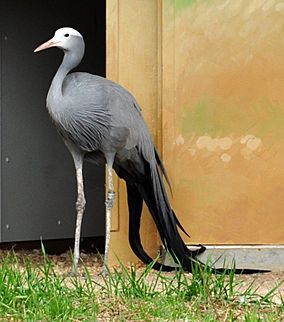International Crane Foundation facts for kids
Quick facts for kids International Crane Foundation |
|
|---|---|

A blue crane at the International Crane Foundation
|
|
| Location | E11376 Shady Lane Rd, Baraboo, Wisconsin, 53913 |
| Area | 240 acres (97 ha) |
| Established | 1973 |
| Website | www.savingcranes.org |
The International Crane Foundation (ICF) is a special group that helps protect cranes. They are a non-profit organization, which means they work for a good cause, not for money. ICF also protects the places where cranes live, like their homes (ecosystems) and the paths they fly (flyways).
This foundation started in 1973. Its main home is in Baraboo, Wisconsin. There, you can visit a 250-acre property. It has live exhibits of all 15 types of cranes! You can also find a visitor center, places to help cranes have babies, and nature trails.
ICF works all over the world to help cranes. They have offices and partners in many countries. This includes places like China, Cambodia, India, South Africa, Texas, Vietnam, and Zambia. About 80 staff members and hundreds of experts work together. They help cranes in over 50 countries on five continents.
How the International Crane Foundation Started
The International Crane Foundation began in 1973. It was started by two students from Cornell University. Their names were Ron Sauey and George W. Archibald. They were studying ornithology, which is the study of birds.
These two friends had a big idea. They wanted to create an organization that would do many things. This included research, raising cranes, restoring natural areas, and teaching people. Their goal was to protect all 15 types of cranes in the world.
In 1973, Ron Sauey's family rented their horse farm to Ron and George. They rented it for only $1 a year! This is where the International Crane Foundation first started in Baraboo, Wisconsin. The organization moved to its current, larger location in 1983.
George Archibald's Special Work with Cranes
George Archibald was the director of ICF from 1973 to 2000. He created new ways to raise cranes that were born in captivity. One amazing method was using crane costumes. Human handlers would wear these costumes to act like parent cranes. This helped the baby cranes learn how to be real cranes.
George Archibald spent three years with a very rare whooping crane named Tex. He acted like a male crane for her. He would walk, call, and dance just like a crane. This helped Tex feel comfortable enough to lay an egg.
Thanks to George's hard work and a special process called artificial insemination, Tex laid a fertile egg. From this egg, a chick hatched! They named the baby crane Gee Whiz. This was a huge step in helping save rare crane species.
Helping Cranes After a Storm
The International Crane Foundation also had an office in Rockport, Texas. In 2017, a big storm called Hurricane Harvey destroyed this office. But the foundation plans to rebuild it.
This Texas office was important because it was near the Aransas National Wildlife Refuge. This refuge is a very special place. It is where the last wild group of whooping cranes lives. Helping this area is key to protecting these rare birds.

